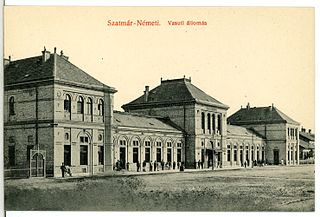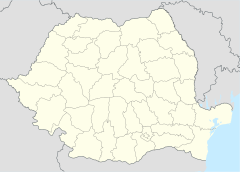Căile Ferate Române was the state railway carrier of Romania. The company was dissolved on 1 October 1998 by splitting into several successor companies. CFR as an entity existed from 1880, even though the first railway on current Romanian territory was opened in 1854. CFR was divided into four autonomous companies:

Beclean is a town in Bistrița-Năsăud County, in north-eastern Transylvania, Romania. The town administers three villages: Coldău, Figa (Füge), and Rusu de Jos (Alsóoroszfalu).

Pașcani is a city in Iași County in the Western Moldavia region of Romania, on the Siret river. As of 2021, it has a population of 30,766. Five villages are administered by the city: Blăgești, Boșteni, Gâstești, Lunca, and Sodomeni.

Sinaia railway station serves the Sinaia mountain resort in Romania. The first station was built in 1913 by the Demeter Cartner Company, and it was reserved exclusively for the Royal Family and its guests at Peleș Castle, generally foreign leaders.

Titan Sud is a small train station located in the Eastern side of Bucharest, Romania, near the Republica metro station and the Republica Factory.

Constanţa railway station is the largest station in Constanţa and on the Romanian Black Sea coast.

Timișoara North railway station is the main railway station in Timișoara and also the largest railway station in western Romania. With an average daily ridership of about 5,530 passengers, Timișoara North is one of the busiest railway stations in Romania.

The Brașov railway station is the main station in Brașov, Romania. The building on the current location was opened to traffic in 1962. The station's bell chimes preceding the announcements represent a few notes from Ciprian Porumbescu's operetta Crai Nou.

Sibiu railway station is the main railway station in Sibiu, Romania.

Sânmihaiu de Câmpie is a commune in Bistrița-Năsăud County, Transylvania, Romania. It is composed of six villages: Brăteni (Mezőbarátfalva), La Curte (Köbölkútitanyák), Sălcuța (Fűzkút), Sânmihaiu de Câmpie, Stupini (Mezősolymos) and Zoreni (Lompérd).

Telciu is a commune in Bistrița-Năsăud County, Transylvania, Romania. It is composed of four villages: Bichigiu, Fiad (Bánffytelep), Telcișor, and Telciu.

Faraoani is a commune in Bacău County, Western Moldavia, Romania. It is composed of two villages, Faraoani and Valea Mare (Nagypatak).

Șoimuș is a commune in Hunedoara County, Transylvania, Romania. It is composed of ten villages: Bălata (Balátatelep), Bejan (Bezsán), Bejan-Târnăvița (Bezsántelep), Boholt (Boholt), Căinelu de Jos (Alsókajanel), Chișcădaga (Kecskedága), Fornădia (Fornádia), Păuliș, Sulighete (Szúliget), and Șoimuș.

Line 300 is one of Căile Ferate Române's main lines in Romania, having a total length of 647 kilometres (402 mi). The main line, connecting Bucharest with the Hungarian border near Oradea, passes through Ploiești, Brașov, Sighișoara, Teiuș, and Cluj-Napoca. The section between Bucharest and Ploiești is shared with CFR line 500.

Satu Mare railway station is the main station in Satu Mare, Romania. It is located near the city center. The station was first constructed in 1870; the current building dates from 1899 and was designed by the architect Ferenc Pfaff.

Regio Călători is a private rail company headquartered in Brașov, Romania. It was founded in 2005 and is exclusively active in the passenger transport sector. At present Regiotrans runs about 200 train services per day.

The Agnita railway line was a 760 mmBosnian gauge rail line in Sibiu County, Romania. Originally it ran from Sibiu railway station to Sighișoara in Mureș County. There also was a branch line to Vurpăr. However the final section from Sibiu to Agnita was closed in 2001. Căile Ferate Române (CFR) classed the line, along with the Vurpăr branch, as line 204 in the last years of operation. The Sibiu Steam Locomotives Museum holds the last remaining original locomotive from 1896.

The CFR Class TEA was a small series of Electric Multiple Units (trains) manufactured in Romania from 1974 to 1986 for Căile Ferate Române. Due to its rarity, not much is known about this trainset, albeit a technical sheet designed for potential export does exist online.

Vicșani is a railway station near the town of Siret in Suceava County of northern Romania, 7km south of the Ukrainian border, on the line north from Bucharest.

Valea Vișeului is a railway station near the town of Valea Vișeului in Bistra commune, Maramureș County of western Romania, close to the Ukraine border.
























